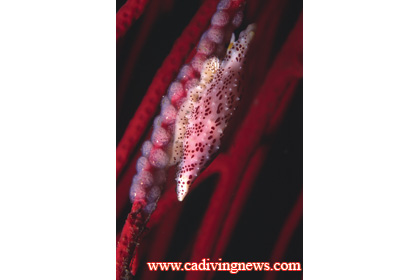Some of California’s underwater critters are easy to find–they swim right up to you. Others are shy and reclusive and you have to hunt for them. Still others are so well camouflaged that they can be right in front of your face and you may never see them. These ultimate masters of disguise are among the most intricate and beautiful of our marine life, and are well worth the effort it takes to find them. In California waters the snail simnia is clearly in the category of hard-to-find and very beautiful.
Simnia are classified into the Phylum: Mollusca–soft bodied animals with (usually) hard shells. They belong to the Class Gastropoda, meaning stomach-footed–although reproductive organ-footed would be a better choice. They are further classified into the Order Sorbeoconcha. This is a very large taxonomic order of snails often with an operculum–a trap door to close their shell. These are primarily marine snails, although a few live in freshwater.
Within the Order Sorbeoconcha, simnia are found in the Superfamily Cypraeoidea–cowries and cowry-like animals. This superfamily contains the families Cypraeidae–the true cowries and Ovulidae–the egg snails. Simnia are ovulids and most have smooth shiny shells with a very long aperture and a very low or invisible spire. In a few species of ovulids the shell quite closely resembles that of cowries. However in most species, the shells are so elongated that they do not resemble the shells of cowries at all. Simnias are formally named Delonovolva aequalis, which roughly translates to “even or symmetric womb.”
Simnias grow to only about an inch long, and have an elongated, white or pink shell with an open slit that runs from end to end. The shell it itself is not particularly interesting. However, like all Cypraeoidea, they grow their shells using a fleshy mantle that extends over the entire shell, and this mantle lays down new shell material. The mantel of the simnia is the most interesting and colorful part of the animal.
Ovulids are a large group of small to large predatory or parasitic sea snails that live on, and eat, soft corals and sea fans, and they are usually regarded as parasites of these sessile colonial organisms. Simnia are range from Monterey Bay to Isla San Martin, Baja California, and are particularly common in the Channel Islands. They are found from 30 to 100 feet, but only on the red gorgonian (Lophogorgia chilensis). These snails have adapted to a life that completely relies on the red gorgonian. They feed on the gorgonian polyps; they live on and lay eggs on the gorgonian stalk. They have so completed adapted to their host that their mantel has evolved a gorgonian-like color and nubs that resemble their polyps.
There are girl and boy simnia. After mating the girls lay thousands of eggs in a dozen or so bubble-like egg cases. These are laid end-to-end on the gorgonian stalk and resemble white opals on a red string. After the eggs hatch the young simnia are pelagic and do not resemble their parents. After an unknown period of time, they settle to the bottom and find another gorgonian to live on.
It is incredible just how well camouflaged these snails are. Their mantles so closely resemble their host gorgonian that you will have to look very hard to spot them. Look for a polyp-covered bump on the gorgonian; this is most likely a simnia. Look away and back; even though you “know” where the snail is, it will take some effort to find it again. On your next dive study each gorgonian very carefully. You may find a simnia. You may also find an equally interesting and camouflaged critter as well, since most gorgonians are home to numerous species of tiny fish and invertebrates.










